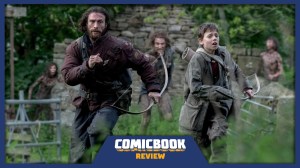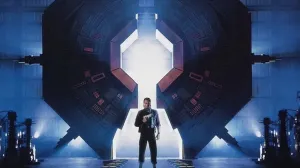Danny Boyle and Alex Garland have never shied away from bold filmmaking and storytelling. Their respective filmographies, including their first collaboration, 28 Days Later, are often full of big swings, stunning visuals, exciting and emotional stories, and unforgettable characters. All of this, plus their occasional desire to delve into the dark and complex facets of humanity, is front and center in this year’s British horror drama 28 Years Later. Beyond the fictional narrative centered on Britain being quarantined for decades after the release of the Rage Virus and the survivors left behind, the highly anticipated sequel was infused with references to real-life horrors, one in particular that British fans might find particularly disturbing. Recently, Boyle and Garland discussed the controversial final minutes of the film and why they are significant for the trilogy as a whole.
Videos by ComicBook.com
WARNING: Spoilers below for 28 Years Later
Speaking with Eammon Jacobs for Business Insider, Boyle and Garland address Jack O’Connell’s introduction as adult Jimmy in the jarring final scene of 28 Years Later. We first meet the character when Jimmy is a child at the beginning of the film, when the infection has just started to spread across Britain. The young Jimmy witnesses the brutal deaths of his sisters and the rest of his family (including his father, a priest who believes this to be Judgement Day and gleefully welcomes death) but manages to escape the violent onslaught of the infected. Nearly three decades into Britain’s isolated dystopian existence, Jimmy has evolved into Sir Jimmy Crystal, a cult leader whose character was apparently inspired by the real-life British star and sexual predator Jimmy Savile.
As the BBC explained in its profile of Savile, he was a popular DJ and a huge media personality in the UK for decades, with a pervasive presence in British culture. He was best known for hosting the show Top of the Pops in the 1960s and was the presenter on Jim’ll Fix It from the 1970s to the 1990s, where children would write to the show and Savile would grant their wishes during each episode. A year after Savile’s death in 2011, hundreds of allegations came out that he was a prolific sexual abuser, mainly of children. As the BBC reported, Savile used his status and fame to target his victims for decades. It was later revealed that the BBC “missed opportunities to stop ‘monstrous’ abuse… because of a ‘culture of fear.’”
A big giveaway in 28 Years Later that Jimmy is meant to resemble Savile is the distinctive wardrobe he (and his followers, the Jimmies) sport: a blonde wig, colorful tracksuits, and gaudy jewelry, looking like a creepy Savile Halloween costume. As soon as you look up a photo of Savile, the similarities are undeniable. Obviously, having a real-life monster inspire such an important character in the movie was intentional on the filmmakers’ part. Boyle and Garland explain in the TikTok clip above that O’Connell’s Jimmy is partially linked to the ongoing trilogy’s crucial theme of memory and how that plays into the characters’ different ideas of shaping “better worlds.”
“The whole film — and if we ever get to make it, the whole trilogy — is in some ways about looking back and looking forwards, and the relationship between looking forwards to better worlds or attempting to make better worlds,” Garland said. “Or, trying to construct the world that you’re in on the basis of old worlds… The thing about looking back is how selective memory is and that it cherry picks and it has amnesia, and crucially it also misremembers. And we are living in a time right now which is absolutely dominated by a misremembered past.”
“It’s all kind of twisting in this partial remembrance, clinging onto things and then recreating them as an image for followers,” Boyle added.
With selective memory being such a huge theme driving the story (i.e., the way cancer affects Isla’s memory, Jamie embellishing stories and outright lying sometimes about prior events, Dr. Kelson focused solely on remembering the dead and how we “must die”), it is interesting how Boyle and Garland correlate that with the UK’s memories of Savile and how that will play out with the character of Jimmy in the sequel, 28 Years Later: The Bone Temple.
It’s established in the opening of 28 Years Later that Jimmy and his sisters were raised on popular kids’ programming at the time (Teletubbies, for example) and likely would have seen Savile’s show as well. Jimmy experienced an extremely violent and traumatic event as a child. His trauma possibly melded with the few positive memories he had as a kid before the infected, namely the TV characters and personalities Jimmy grew up with in the ’90s — on top of his religious upbringing that is obviously significant as he still has his father’s cross, which he wears upside down similar to how the Jimmies often hang the infected upside down with “Jimmy” carved into their torsos. All of this will potentially play a part in shaping how the cult leader persona he has cloaked himself in as an adult informs what Jimmy envisions a “better world” built on a cherry-picked past should be.
Memory and nostalgia may also influence Spike’s (Alfie Williams) perspective on Jimmy and his crew. At the beginning of 28 Years Later, before Spike leaves with his dad on his first pilgrimage to the mainland, we see that one of his toys is a red Power Ranger. While the ending feels bizarre with the parkour flips and colorful tracksuits, consider Spike’s perspective of this moment: a group of “superheroes” in vibrant outfits showing up and saving his life, similar to how he might picture the Power Rangers. Even though Spike has minimal exposure to these popular TV characters and has never seen any of the movies or series with zero firsthand knowledge of life before quarantine and the infected, that Power Ranger toy is clearly an important part of his childhood. This seemingly heroic first meeting could be part of the pull and trust Spike has towards the charismatic Jimmy moving forward.
Spike shaking Jimmy’s hand in the final moments of 28 Years Later, especially after losing his mother and becoming disillusioned by his father and the somewhat insidious, isolated community on Lindisfarne he’s grown up in, leaves a lingering feeling of dread for the 12-year-old as fans wait to see what comes next.









